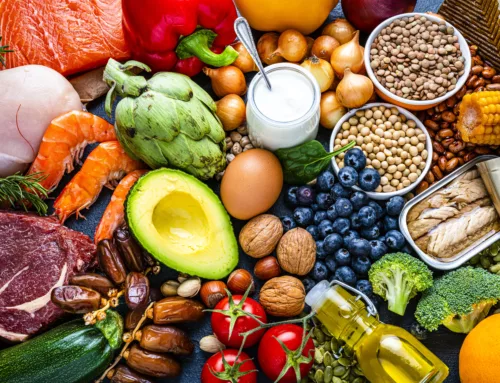Many of us have gone through a “boiled chicken and rice” phase that was not only visually the food equivalent of the color gray, but was equally matched with its dull, even nonexistent, flavor.
Maybe you were trying to take charge of your nutrition and start eating healthier, or maybe you were too tired to cook a gourmet meal. But there are two common outcomes when we force ourselves to eat food, specifically food labeled as healthy in our minds, that doesn’t taste good and that we don’t enjoy.
The first is we give up on eating healthy and resort back to the saltier, fattier, far more unhealthy food choices that actually taste delicious. But more often than not, this can trigger feelings of guilt, and even sometimes binging. The second outcome is it can sometimes turn us off to eating entirely. If we’re trying to eat healthy, but eating healthy is a tasteless, joyless experience, we may just stop eating altogether, which is a deep problem in and of itself.
Eating for your body and your mind
There are two equally important reasons for eating: fueling our bodies on a nutritional, survival level, and fueling our mental health in a positive, pleasurable way. To achieve balance, to nourish a healthy relationship with yourself, your body and food, you have to eat your meals for both reasons.
Eating a healthy meal you hate is not going to leave you satisfied, because you are lacking the mental enjoyment aspect of eating, even if you have the nutritional aspect. But most of us aren’t taught how to cook tasty nutritious meals, and instead, we look at meals as being either tasty or nutritious, but not both.
Learning how to cook delicious, good-for-your-body-and-soul meals is going to be key in both your recovery and your overall journey in promoting health and balance in your life.
Shifting your mindset around food
For decades now, people have made fun of healthy food for being both visually unappealing and repulsive to the tastebuds — but in reality, nutrient-dense meals can be some of the most delicious, satisfying foods you’ve ever enjoyed.
There’s a reason why home-cooked meals are craved and treated with an almost-reverence, especially by those who rarely or never get to enjoy them. It’s the same reason why farm-raised ingredients are quickly becoming a staple in many homes and restaurants: the quality and flavor are unmatched.
It can be overwhelming to know where to begin with adding healthy but delicious flavors into your meals, but that’s exactly what we’re going to cover in this article.
Watching out for toxic ingredients
You might be tempted to just swipe a jar of sauce or a seasoning packet to add some vibrant flavor to your boiled chicken and rice, but unfortunately most pre-made condiments and seasonings are full of unhealthy ingredients. These additives are not only unhealthy, but they can actually actively damage your health and even cause additional illnesses and disorders.
Four of the most common toxic food additives are:
- Monosodium glutamate (MSG), typically used to enhance salty or savory flavors
- Artificial coloring, flavoring and sweeteners which are commonly used in sweets, snack foods and many frozen and pre-packaged meals
- Sodium nitrite (a potentially cancerous preservative) used in deli meats
- High-fructose corn syrup, commonly used in baked goods, candies and snack foods
You might be thinking it’s nearly impossible to find delicious food that doesn’t contain any of these unhealthy additives and you aren’t exactly wrong. If you’re focusing on pre-made, pre-packaged foods, it will be difficult to find tasty, truly nutritious meals.
The surest, simplest way to enjoy delicious and nutritious meals is to cook them yourself. And while it might seem tedious right now, once you find your rhythm in the kitchen, you might even find yourself enjoying experimenting with different flavors in your dishes.
Different flavor combinations
The healthiest flavors are those that you create yourself through herbs, spices and seasonings. One of the ways you can start building your flavor repertoire is by identifying which cuisines your palette likes most.
For instance, if you enjoy the flavors of Italian food, use ingredients such as basil, oregano, garlic, red pepper flakes, parmesan, tomato and of course, olive oil.
If you can never have enough Chinese food, be sure to keep soy sauce, garlic, ginger, sesame oil, oyster sauce (it’s not as weird as it sounds) and chili oil in your cabinet.
And if Mexican food is what makes your tastebuds happy, focus on using spices such as onion, garlic, cumin, chili powder, cilantro, smoked paprika and chipotle.
Here are some other unique ways to make an otherwise plain dish taste incredible:
- Instead of boiling or sauteing vegetables, toss them with olive oil, salt and pepper and roast them in the oven
- Try adding a sweet element to your green salads, such as apples, pears or craisins
- Consider adopting a few herb plants to keep your kitchen, as fresh herbs can make a huge difference in flavor
- If you want to use salt, opt for sea salt or Himalayan salt, instead of the average table salt, which is bleached and has no nutritional value
Want additional support?
Establishing new eating habits can be overwhelming, so we are here to help you create a lifestyle that’s not only good for your body, but enjoyable and as easy as possible.
Give us a call today at 828-490-4032.






